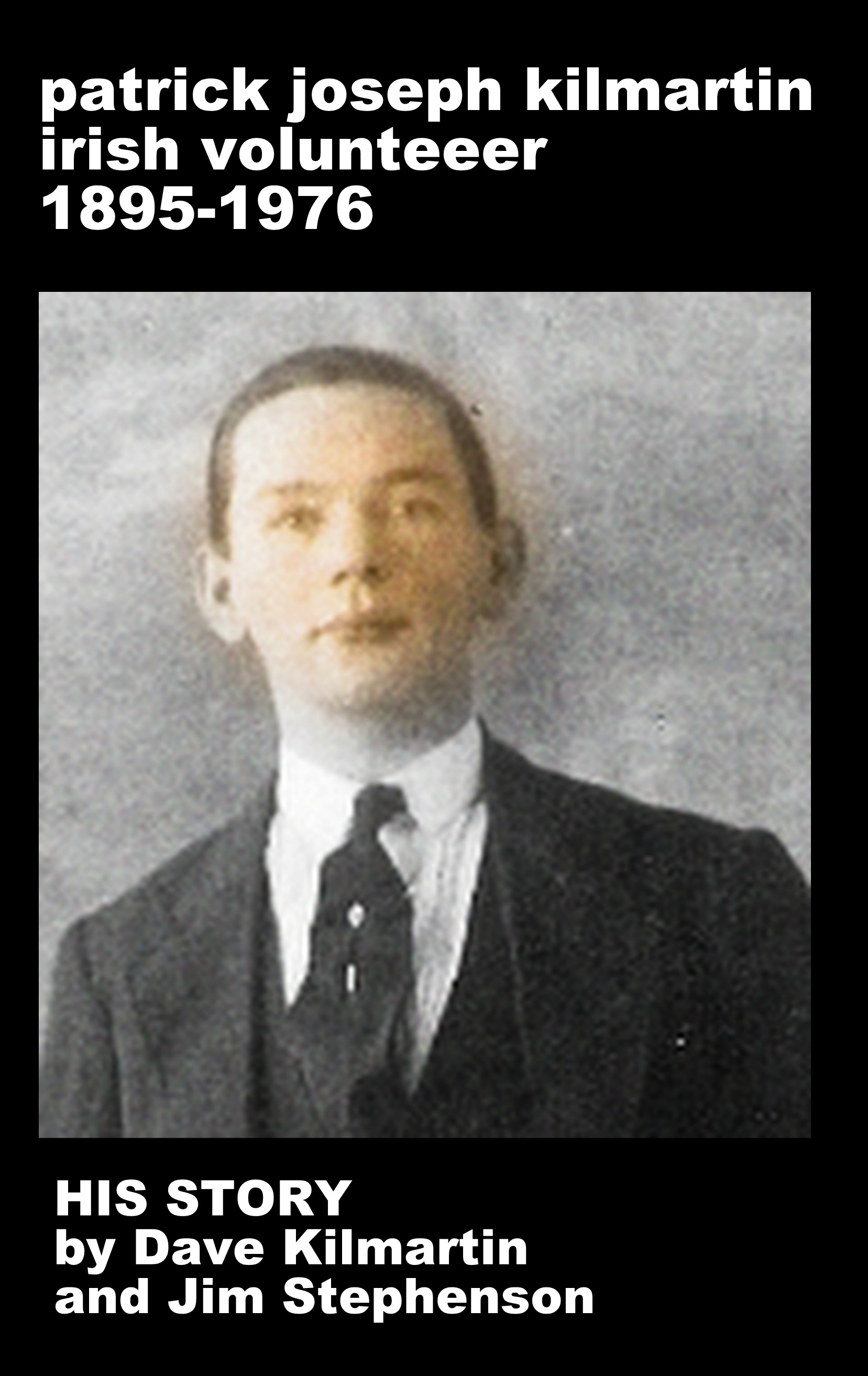Patrick J. Kilmartin
1916 Easter Rising
Paddy Kilmartin fought for Irish Freedom in the Easter Rising of 1916.
As an Irish Volunteer he mobilised on the Bank Holiday and fulfilled his part in the Irish rebellion serving in the Phibsborugh and GPO HQ areas, until his arrest and internment in Arbour Hill, Kilmainham, and later in England’s Wakefield Prison.
As was typical of the 1916 veterans, Paddy K. did not normally discuss the important part he played in the Rising, however, the fight in the Phibsborugh area is reasonably well documented, regarding the part the small troop of some 25/30 men played under the command of a Captain James O’Sullivan.
Sean Heuston’s younger brother, Father J.J.Heuston OFM, when he wrote about D Coy. 1st Batt. lists Patrick Kilmartin as serving in the Phibsbourgh and later HQ areas, in his book ‘Easter Week 1916’ page 69.
Paddy K was to acquire a brother-in-law on the marriage of his sister Mary to Patrick Stephenson in 1917, who had been courting Paddy K’s sister Mary known as Mamie for some time and they had become close friends.
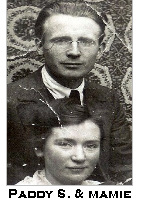
Paddy S. had followed Paddy K’s example and joined the volunteers in 1915, he was a member of D Company 1st Battalion, Dublin Brigade and he also served during Easter Week, and it was he who was to document the details of the parts played by himself and Paddy K.
In Department of Defence archives in Renmor Co Galway, there is a deposition by Paddy Kilmartin, which fortunately his grandson David Kilmartin has been able to obtain copies of. In these Department of Defence documents it is possible to read in some detail of Paddy K’s. actions which are attested to by three witnesses, persons who also served, and signed by a peace commissioner in the 1930s.
Paddy K’s nephew Patrick Heuston Stephenson has also documented the stories his uncle told him on those rare occasions when he would be encouraged to discuss that important episode in Irish History, these discussions were usually led by a good friend of Paddy K’s a Capuchin priest Fr. Henry OFM cap, Whom he knew from his school days and who became a strong acquaintance of Paddy K. Paddy S. and Paddy H!
Of course, there are also accounts of various actions that have been handed down to new generations from Paddy K’s children
Easter Sunday 22nd April 1916
Earlier on the Easter Sunday morning Paddy Kilmartin (Paddy K) had been enjoying a rare day off from his Mother’s fruit and vegetable shop at 23 Stoneybatter. As it was Easter weekend the shop had been closed from Good Friday through to Easter Monday and after a leisurely Easter Sunday Morning breakfast with his Mother and his younger sister Mary, he went for a walk.
As he was under orders to turn out on a volunteer route parade the following day Paddy K. decided he would enjoy some peace and quiet, in the spring sunshine by strolling up to Phoenix Park. In Manor Street, he met his friend Patrick Stephenson (known as Paddy S. & Paddy Joe) who was on his way to visit Mary his future wife and Paddy K’s sister. Paddy S. had a copy of the Sunday Independent which contained the famous countermanding order from the chief of Staff, Eoin MacNeill, in which the previous orders for all volunteers to mobilise for Easter manoeuvres and route marches were cancelled.
In order to get clarification both the young volunteers decided that they would go to the Colmcille Hall, no, 5 Blackhall Street, which was the drill hall for their company, on arrival they saw preparations for a cleilidhe to be held that night, but there was no one there that could help them with their query on the countermand, they then decided to make their way to the HQ of B Company in Rutland now Parnell Square.
On the way the pair met with Garry Houlihan, a volunteer Officer, and sought clarification from him. He could not confirm what was happening, he was on his way to Liberty Hall to seek clarification, but asked the pair to go to and see Sean T .O’ Kelly, who was a rebel officer, in his house in Rutland Street to see if he had any information.
As it was on their way they agreed, however they did not get any answer when they knocked on the door. It turns out that the Pearse brothers had spent the night there and were inside ignoring any visitors, and were holding meetings to decide the actions they would subsequently take. Having got no answer, and not having met anyone at B Company HQ Foresters Hall, both Paddy S. and Paddy K. returned to their respective homes none the wiser, and agreeing that they would later report to D company HQ at Colmcille Hall.
When they arrived at the drill hall in Blackhall the ceilidhe was nearing its close there was an air of great uncertainty among the more than one hundred volunteers there, and young Captain Sean Heuston O.I.C. ‘D’ company was explaining to about a doz. of his company that they should report back to the hall later that evening as they would be required to guard the hall that night against a possible British military raid and that they would lead the route march early the next morning.
There was a very strong hint in his voice of impending important events of greater import than a mere route march. this excitement was then supplemented by the arrival of Commandant Edward Daly who briefed the growing number of volunteers that they should prepare for manoeuvres the following day.
Due to the MacNeill order in the newspapers it was clear that the number of volunteers that might have turned out was diminished and as a result Paddy K was told by his Captain Sean Heuston that he would be transferring to B Company in the morning on a temporary basis and to report to a Captain James O’Sullivan in the North Circular Road area.
Paddy S. was told by his Captain Sean Heuston to report to St Stephens Church at 11am on that Easter Monday Morning
Before the volunteers were dismissed both Paddy Kilmartin, Paddy Stephenson and about two dozen volunteers stayed over at Sean Heuston’s request and mounted a guard in the Drill Hall throughout the night, in order to protect their arms cache including some homemade bombs hidden in the building against that possible raid.
During the night by meagre candlelight the volunteers kept themselves amused by singing songs about Ireland’s independence and freedom.
The following day Paddy Kilmartin returned to his home at 23 Stoneybatter get his revolver, his Lee Enfield rifle and ammunition. Over the preceding months he had agreed to store the arms, ammunition and equipment of a number of other volunteers. In fact his home had become a place for freedom fighters to hide their weapons, but not from the authorities, as carrying weapons by the volunteers in public was tolerated by the British at that time, the weapons were most likely hidden from the volunteers own families as the young men and women of the part-time militia, did not always have the approval of their parents for their activities, in fact it was often considered a foolish waste of time.
The opposite could be said of Paddy K’s Mother, Mary Kilmartin, the founding owner of the shop, Kanes, as she was very sympathetic to the Republican Movement and the cause of freedom for Ireland, she was an ardent Republican and was not only fully aware of the stash of arms and ammunition in her home and shop, but condoned it.
It was with significant encouragement from his Mother Mary, that Paddy had joined the Irish volunteers in 1913 when he was only 18; he was funded by his Mother and attended the inaugural meeting of the Irish volunteers at the Rotunda in November 1913 where he signed up and joined the struggle for Irelands Independence.
D Company 1st Battalion was selected in 1915 as the company that would provide protection to the Volunteer Council headed by Eoin MacNeill and other senior Council members such as Bulmer Hobson.
Paddy K was often selected for guard duty at no 2 Dawson Street the HQ of the volunteers and recalls that he was once a bodyguard to Joseph Campbell the poet, a member of the Council, at a meeting in the winter of 1913 at Wynn’s Hotel in Abbey Street, escorting him to the hotel from Austin Clarke’s house which was also in Stoneybatter, and it was there that Campbell, who was from Wicklow used to stay.
Whilst Paddy K. stood guard outside the hotel for the duration of the Council meeting he saw it was also attended by Patrick Pearce, Eoin MacNeill The O’Rahilly and Eamonn Ceannt among others.
That started a passionate involvement in which Paddy K played a full part in training, drilling, and most importantly in arms procurement. He was excused parades as being too public in light of his dealings with the Army in obtaining arms.
Paddy K proved to be very adept at securing weapons, particularly from Irish born members of the British Army, who deserted in large numbers in light of World War I and sold their .303s complete with ammunition belts and bayonets for up to £2. Paddy often accompanied Sean Heuston and Paddy Stephenson to Kingsbridge Station (now Heuston Station) armed with revolvers in order to meet the troop trains from the provinces, the pickings were rich in terms of obtaining rifles. Guns were placed against the wall while the Tommies wet their whistles, and concentrated on the game of cards they played in the station bars. Paddy K would stand guard as Sean Heuston would casually walk past the soldiers and pick up a rifle hiding it beneath his long coat without missing a stride.
Paddy K had also taken part in the historic gun running episode at Howth in July 1914 marching back into Dublin and under orders from Ned Daly his Commandant and one of the officers under Bulmer Hobson, who was aware of the waiting police cordon. Sections of the volunteers were ordered to disperse and take the rifles to safe places after giving their addresses to their officers.
Paddy K was known to the Ned Daly as a fellow member of the Dublin retail community, and it was he who instructed Paddy K to take one of the few handcarts, with two dozen Rifles destined to be issued to some officers later, to Stoneybatter. Paddy K did so with help of two young Fianna scouts and he avoided the police and the melee in Clontarf by circumventing the area at Raheny, and safely arriving at Kanes via Phibsbourgh.
Easter Monday 23rd April 1916
Easter Monday morning started with breakfast at D company 1st Batt. Headquarters, the local Hall in Blackhall Street and the menu was a mug of very strong tea with dried toast and some boiled eggs. Some of the volunteers were in such a nervous state that the boiled eggs did not stay long in their stomachs.
Once again it was a bright Spring Easter morning when Paddy Kilmartin made his way towards the North Circular Road and the railway bridge spanning the Cabra Road. Paddy would have made his way from Stoneybatter, via Grangegorman, and along the North Circular Road towards Phibsborough, onto Charlotte Road and the Cabra Road, turning right towards the railway bridge.
Upon arrival Paddy saw the tall Limerick man Captain O’Sullivan directing volunteers in the construction of barricades and Paddy quickly set to and spent the rest of Easter Monday assisting in the building of barricades and the occupation of some nearby houses. He was allocated the specific occupation of a house called Mountain View on the North Circular Road.
The barricades were made up of miscellaneous items purloined by the volunteers from nearby houses and businesses and were made up of large items of furniture, vehicles of all sorts, carriages and carts. The volunteers had placed barricades both on Park Road and on Cabra Road itself, near to the point at which Charleville Road linked it to the main thoroughfares.
Houses overlooking the barricades were occupied by volunteers. Many of the houses in that area were empty, in that the occupants were either away enjoying the Easter Holidays, or on days out to the coast, or to the Fairyhouse Easter Races.
The barricades were constantly manned by volunteers throughout the day. Once the barricades were complete the attention of the dozen volunteers turned to securing some key buildings overlooking the main thoroughfare to the city. It was clear to Paddy and his fellow volunteers that the rising was indeed in earnest when they heard the distant sound of rifle fire in the early afternoon, which in all probability was fire from the Mendicity on troops who were attempting to make their way along the Liffeyside towards the city, it was among the volunteers at that garrison that Paddy S. was serving.
Paddy K. spent the night in one of the first floor rooms of Mountain View house after he had helped with the preparations to secure the building for defence and as supplies were sparse particularly food. He quickly returned home to Stoneybatter to get some food and a warm blankets, along with the rest of his ammunition. After which he returned to Mountain View, but did not enjoy a great deal of sleep as it was possible to hear gun fire in the City Centre which led to much excited discussion with his volunteer colleagues throughout the night.
Tuesday 24th April 1916
Tuesday morning was bright and clear and the area which Paddy Kilmartin and his Company were located was quiet throughout the day until Tuesday afternoon when the forward Scouts for the British Forces came under fire from the volunteers, both from the barricades and the houses they occupied.
The fighting was fierce with constant rifle and machine gun fire from the Tommies being returned in no mean measure from the small but well armed company of Irish volunteers.
Paddy K. was always reluctant to talk about the fighting but did say that whilst he could clearly see the soldiers he was firing at he was never sure if he hit any of the troops.
These were the 1st British troops to attempt to enter the city in response to the rebellion. It was here that would be the first actual entry point for any British Forces from outside the city.
B Company in 1st battalion under Ned Daly had the job of protecting the main rebel group in the city from British troops entering the city from the North and Northwest, the additional task for B Company was to keep clear the Joseph Plunkett plan, of a corridor for retreat to Ulster if needed.
It was a group of Royal Dublin Fusiliers that managed to force their way towards the Cabra Road but the insurgents successfully pinned down the Tommies until some well placed artillery shelling destroyed the barricades forcing the volunteers to retreat to the nearby houses.
This withdrawal then allowed for the British Military to circumvent the rebels and to secure Broadstone Station and that allowed the crown forces the possibility of further troop movements into the City by rail. This was of course, exactly what the ‘B’ Company, 1st Battalion under Captain O’Sullivan was there to prevent, but that said it was also the task of the main body of the 1st Battalion from the Four Courts to take Broadstone at an earlier stage in the fight but it was for some reason undertaken too late in that when the advance party approached the station it was discovered that the British troops already occupied it.
Captain O’Sullivan was unaware that the British troops had managed to take control of Broadstone terminus.
Despite the uncomfortable fact that the houses they occupied came under artillery, machine gun and rifle fire, the volunteers continued to hold these positions, and it is recorded that there were a number of civilian casualties resulting from stray bullets and shrapnel.
During the night of Easter Monday in the house on the north Circular road called Mountain View, Captain O’Sullivan and a number of the volunteers had discussed the possibility of destroying the railway lines and junction boxes to prevent further reinforcements, particularly artillery, reaching Dublin. It was at this juncture that Paddy Kilmartin was selected for the hazardous task of making his way to the General Post Office on Sackville Street and obtaining some dynamite and explosives in order to blow up the railway bridges leading to Broadstone Station.
Early on Tuesday afternoon Paddy K. armed with his Lee Enfield rifle, made his way along Cabra Road down towards the Great Western Square and York Place on to Phibsborugh Road, past Broadstone Station unaware that it was garrisoned now with British troops. Incredibly he passed it by without incident onto Mountjoy Street, Mary Street on to Granby Road past Rutland Square and into Moore Street. Paddy Kilmartin arrived at the General Post Office entering through the rear and reporting to the Quartermaster at the Headquarters GPO.
He presented his request from Captain O’Sullivan for the explosives. Before he had obtained the dynamite he was ordered to give a verbal report to James Connolly on the situation at Phibsborugh after which he was instructed by Connolly to bring good tidings to his fellow fighters.
The GPO was under spasmodic light arms fire while Paddy K was in the building and it was some time before he could leave and he effectively became a garrison member when he was instructed to take up a position at one of the front windows with a borrowed Martini rifle for a number of hours.
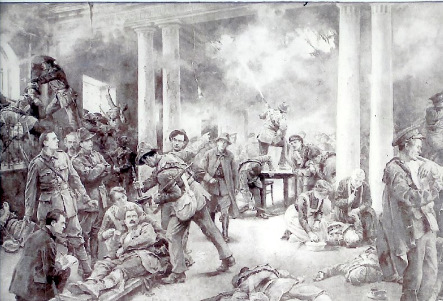
Paddy was impressed by the organisation at HQ with its stores, infirmary, administration areas and whilst giving his short report to Connolly a secretary was typing his dictation to a background of repeated gunfire. Paddy K was able to return to his company by mid-afternoon, also without incident.
Captain O’Sullivan’s plan was to use the dynamite to destroy the railway bridge at North Circular Road in order to prevent the progress of any supply or troop-trains from Athlone, and the North, however upon Paddy K’s return the British forces opened fire with highly accurate artillery shelling of the area with guns that had arrived from Athlone and were now sited on the Cabra Road.
With shells landing on and around their barricades, supplemented with the more accurate machine gun and rifle fire from the Fusiliers, the volunteers had to retreat to cover in some of the houses on the NCR and the attempt to lay the explosives abandoned.
Another 18 pounder was placed at the entrance to the asylum at Grangegormen and that gun was highly effective with shells exploding above the rebels who were now established at the area around the junction of NCR and Cabra road. It was at this stage, only possible for the rebels to seek shelter in the nearby houses only infrequently firing on the soldiers now approaching in greater numbers.
Late in the afternoon the British withdrew and the rebels thought they had seen the Tommies off.
However the troops were to withdraw only to allow for further bombardment which then became intense, destroying the barricades until the only sanctuary was in the nearby houses.
In a lull in the fire Captain O’Sullivan ordered some of the volunteers to withdraw and some were to make their way to their Battalion HQ, and some to go to Ashbourne and reinforce Thomas Ash, whilst keeping a small picket of men that he intended should at dawn, regroup and make their way to and join up with, the volunteers holding the Four Courts on the quays.
Under darkness Paddy Kilmartin and others were ordered to return to the same house on the North Circular road, Mountain View, that he had occupied earlier but noticed that the house had suffered severe damage from shell, shrapnel, and bullets, since the afternoon.
Paddy had noticed that the remaining rations that he had brought from his home on the Monday night lay untouched where he had left them, although there were no other supplies to be had, he immediately shared out the remaining food and three bottles of stout were circulated being well received by all…teetotallers included.
That night O’Sullivan had put a guards rota in place whereby the volunteers took sentry duty for an hour and an hour of disturbed sleep.
Wednesday 25th April 1916
At dawn the group were being roused when a scout arrived to report to Capt. O’Sullivan that the British who occupied Broadstone had spread out into adjacent houses and that in fact the Phibsbourgh Garrison were not only outflanked but surrounded by vastly superior forces with heavy artillery and any planned attempt to join Ned Daly’s forces at the Four Courts would be impossible. No sooner had the scout completed his report when the house was raked with machine gun fire, it was also clear that more artillery was deployed and being used to shell areas of the city behind and beyond O’Sullivan’s position.
O’Sullivan decided that he would surrender and ordered his volunteers to leave their weapons and equipment in the house and to file out of the building under a white flag that he carried and with their hands raised.
The small garrison had to stand at the roadside under the flag of truce for some time but were eventually were surrounded by armed British soldiers, most of whom were Irish, they treated their prisoners well, and they were escorted to a Richmond Barracks detention.
The captured rebels were fingerprinted and details taken and given.
Paddy was held in Richmond Barracks from late on the Wednesday the 25th April until he was transferred with about 30 others to Kilmainham on the Friday 28th April, and then to Wakefield prison in England on the 2 May the day before the firing squads carried out the executions of the leaders of Easter week rising starting with Patrick Pearse .
Paddy K was, along with his fellow prisoners, tired cold and hungry as he was transported by an open army truck from Kilmainham to Kingstown and onto a cattleship steamer in which he was taken to Holyhead in Wales. During the rough seven hour crossing the stink in the hold of the dark cold ship was so severe that a number of prisoners were very ill and were transferred directly to hospital on arrival in port, whilst Paddy and the rest were put on a train to Wakefield prison in Yorkshire.
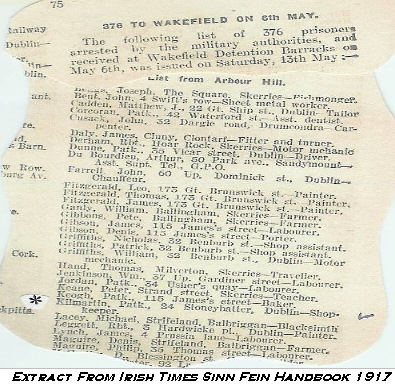
Paddy K was incarcerated in Wakefield Prision until his release on June 2nd 1916.
There is however an unresolved issue in the reference to a ‘Kilmartins Orchestra’ at Frongoch as Paddy K was the only Kilmartin listed as having been detained and he was supposedly interred in Yorkshire?
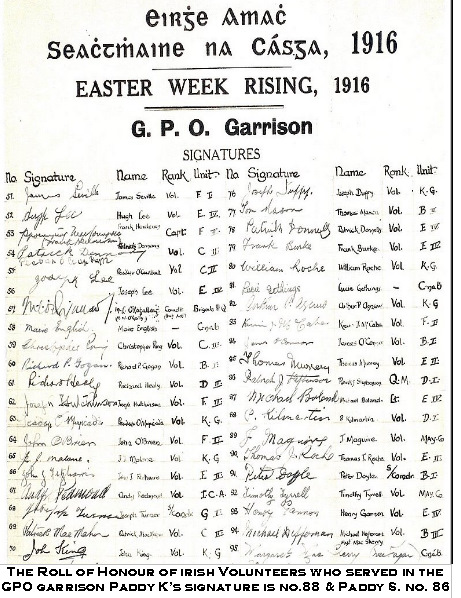
Very little is known of Paddy’s term in prison although there was a concerted effort by the prisoners to harass and make difficulties for the authorities and there were many demands to be treated as prisoners of war, with numerous demands such as daily mass, not wearing prison garb etc. all of which the prison authorities allowed.
On release from jail Paddy K was among the first prisoners to return to Dublin as Irish heroes in that public opinion had changed in favour of the rebels subsequent to the execution of the leaders of the Rising.
Black and Tans
Paddy Kilmartin was very active during the war of Independence for which he received a Combatants Medal. This was a medal awarded to those who fought in arms during the war of independence for those who played a non Combatants role the medal was issued without the Comrac bar.
Because of Kanes shop and the supply of goods to the British, Paddy K came into contact with various logistics personnel which enabled him to obtain critical information about the comings and goings of troops. As a result he was asked to work undercover and was excused participation in parades and drill but continued his role in arms smuggling procurement and storing of arms and ammunition.
Paddy K was honoured for his part in the war of Independence for his role in armed raids on Post Offices and a Pawnshop on Ellis Quay in which shots were fired. He hid stashes of arms in his Mother’s shop and it was raided at least twice by the Black and Tans. The penalty for this was death often administered on the spot. At one stage he was a wanted man and was arrested in Stoneybatter across the road from Kanes and when questioned as to whether he was Paddy Kane he replied that he was not, that he was Paddy Kilmartin, the Tans took him into the nearby pub and asked various people to identify him, luckily they all identified him as Paddy Kilmartin. After which he was released.
He often travelled into the country to get arms and he used John Murray’s car, Murray was a Butcher who rented no 26 Stoneybatter, from Paddy K’s brother-in-law Paddy Joe Stephenson’s family, Murray used to leave his car for Paddy K to use with a full tank and the keys under the bonnet.
Paddy K was not a participant in the Civil War as he did not see any cause that was worth fighting against fellow Irishmen for.
Paddy lived to see the 50th Anniversary of the Rising in 1966 and was awarded a Survivors Medal in the style of the original Easter Week Medal, Paddy was also among the few selected to act as Honour Guard at the Memorial held in Croke Park.
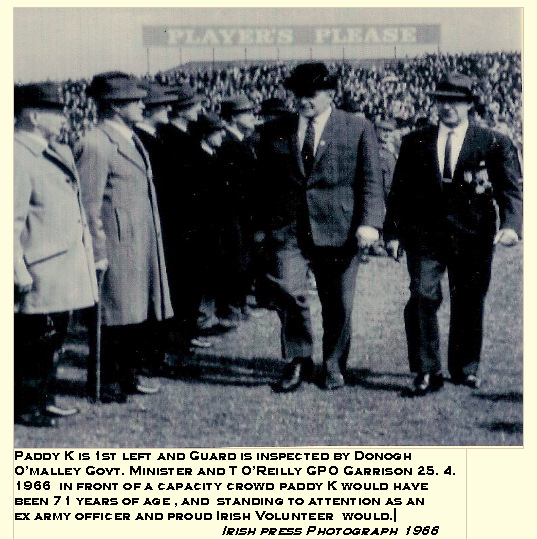
Paddy K is 1st left and Guard is inspected by Donogh O’Malley Govt. Minister and T O’Reilly GPO Garrison 25. 4. 1966 in front of a capacity crowd. Paddy K would have been 71 years of age, and standing to attention as an ex-army officer and proud Irish Volunteer would.
Irish press Photograph 1966
